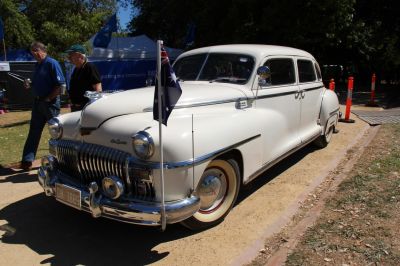 1951 DeSoto Deluxe II 8-Passenger Dimensions, Size & Specs
1951 DeSoto Deluxe II 8-Passenger Dimensions, Size & Specs
Measurements of the 1951 DeSoto Deluxe II 8-Passenger, engineered for optimal performance and comfort
| Dimensions | |
|---|---|
| Length: | 5699 mm224.4 in18.7 ft |
| Width: | 1934 mm76.1 in6.3 ft |
| Height: | 1680 mm66.1 in5.5 ft |
| Ground Clearance: | 210 mm8.3 in0.7 ft |
The DeSoto Deluxe II 8-Passenger, produced between 1951 and 1952, represents a classic example of early 1950s American automotive design focusing on spaciousness and comfort. This large sedan measures an impressive 5699 mm (224.3 inches) in length, offering ample interior space suitable for up to eight passengers, reflecting its designation as an 8-passenger vehicle. With a width of 1934 mm (76.1 inches), the Deluxe II provides a broad cabin feel, while its height stands at 1680 mm (66.1 inches), giving it a commanding presence on the road. The ride height or ground clearance is 210 mm (8.3 inches), suitable for the varied road conditions of its era and contributing to a smooth ride quality. The DeSoto Deluxe II’s substantial dimensions underline its role as a family and executive sedan of its time. Its large size not only accommodated numerous passengers comfortably but also embodied the styling cues characteristic of early 1950s sedans, combining elegance with practicality. This generation of the DeSoto Deluxe sedan remains a notable model for collectors and enthusiasts who appreciate the significance of vehicle size in classic automotive history.
Discover the standout features that make the 1951 DeSoto Deluxe II 8-Passenger a leader in its class
Have a question? Please check our knowledgebase first.
The DeSoto Deluxe II 8-Passenger sedan, produced between 1951 and 1952, is a notably large vehicle for its era. It measures 5699 mm (224.4 inches) in length, providing ample space for passengers and luggage. The width is 1934 mm (76.1 inches), offering a broad stance that contributes to vehicle stability and interior roominess. The height is 1680 mm (66.1 inches), and it features a ride height or ground clearance of 210 mm (8.3 inches), which is fairly generous and helps provide a comfortable ride over uneven surfaces. These dimensions classify the DeSoto Deluxe II as a full-sized sedan that emphasizes passenger comfort and road presence.
The '8-Passenger' designation of the DeSoto Deluxe II refers to its unique seating arrangement, which was designed to accommodate up to eight occupants, a notable feature compared to typical sedans of the early 1950s that generally seated five to six people. This was usually achieved by a front bench seat accommodating three passengers, and a larger rear bench combined with a jump seat or fold-out seats inside the cabin. The length and width of the vehicle facilitate a roomy interior, optimizing passenger comfort over longer trips. Compared to other sedans of that period, the Deluxe II was in the upper segment regarding passenger capacity, appealing to families or users who demanded more space and versatility.
With a length of 5699 mm (224.4 inches or roughly 18.7 feet), a width of 1934 mm (76.1 inches or about 6.3 feet), and a height of 1680 mm (66.1 inches or 5.5 feet), the DeSoto Deluxe II 8-Passenger is quite large by modern standards. Most standard single-car garages today are about 6 meters (20 feet) deep and 3 meters (10 feet) wide. While the car's width fits comfortably within this width, its length is close to the limit of typical garage depth, leaving limited clearance at the front or rear. Therefore, the Deluxe II will fit into a standard garage in most cases, but parking may require careful maneuvering, and garages smaller than average may pose a challenge. Owners of this classic vehicle often benefit from larger or dedicated vintage car garages.
The DeSoto Deluxe II 8-Passenger comes with a ground clearance of 210 mm (8.3 inches), which is relatively generous compared to many modern passenger cars. This higher ride height allows the vehicle to handle uneven roads and light rough terrain more comfortably and reduces the risk of underbody damage from road debris. It also contributes to a commanding driving position and better visibility for the driver. However, a higher center of gravity could slightly influence vehicle handling, especially during sharp cornering. Overall, this clearance suits the road conditions of the early 1950s, where many roads were less refined than today.
The DeSoto Deluxe II 8-Passenger replaced earlier Deluxe models from before 1951, bringing some evolution in size and design. Compared to its immediate predecessors, the Deluxe II typically maintained or slightly increased its overall length and width to improve interior space and road presence. The 1951-1952 Deluxe II's length at 5699 mm (224.4 inches) reflects a continuation of full-size dimensions suitable for its class. Though specific predecessor measurements vary by model year, the Deluxe II generally offered a more spacious, modernized interior and refined styling while retaining a similar footprint. These evolutionary changes helped maintain DeSoto's competitiveness in the full-size sedan market of the early 1950s.
The DeSoto Deluxe II measures 1934 mm (76.1 inches) in width, which is fairly wide relative to other full-size American sedans from the early 1950s. This broad width allows wider seating arrangements inside, contributing to its 8-passenger configuration and overall spaciousness. Comparable models such as the Chevrolet Bel Air or Ford Customline from that era had similar but sometimes slightly narrower widths, typically between 1850 mm to 1930 mm. DeSoto's use of this wider track dimension aimed to deliver a more comfortable ride and improved road stability, marking it as a solid contender among large family sedans of its time.
Standing at 1680 mm (66.1 inches) in height, the DeSoto Deluxe II 8-Passenger sedan features a somewhat tall body profile, which helps maximize headroom and overall passenger comfort inside the cabin. This height is typical for full-size American sedans of the early 1950s, where increased vertical space was a selling point to accommodate taller passengers and provide an airy, comfortable interior environment. The vehicle's design emphasized spaciousness, and the height contributes to an excellent balance between a stately exterior presence and accommodating interior ergonomics for a full eight passengers.
With an overall length of 5699 mm (224.4 inches), the DeSoto Deluxe II is a large vehicle by any standard, especially compared to contemporary compact cars. This length provides plenty of interior space but can pose challenges regarding urban maneuverability and parking. Drivers might find it more difficult to negotiate tight city streets, narrow parking spaces, or crowded lots. Steering technology and turning radius in vehicles of this era were less advanced, which might further affect ease of handling in confined spaces. Consequently, owners typically needed to manage parking carefully, often preferring larger parking spots or garages designed for full-size automobiles.
The DeSoto Deluxe II 8-Passenger stands out among 1950s full-size sedans for its generous dimensions and seating capacity. Its length of 5699 mm (224.4 inches), width of 1934 mm (76.1 inches), and height of 1680 mm (66.1 inches) are at the higher end when compared to models like the Plymouth Cranbrook or the Buick Special. The notable feature is its 8-passenger capacity, which was more than the usual 6 seats found in many competitors. This made the Deluxe II very attractive to families or those needing more transport space. Its size contributed to a comfortable ride and roomy interior, setting it apart as a premium choice in the mid-century American sedan market.
The DeSoto Deluxe II 8-Passenger, produced during 1951 and 1952, represents a classic postwar American full-size sedan molded for both utility and style. Its large dimensions enable comfortable seating for up to eight individuals, a rare feature for sedans at the time, achieved through innovative bench and jump seat arrangements. The exterior styling reflects the rounded, streamlined aesthetic prevalent in early '50s design, with chrome accents and a stately grille. Functionally, the vehicle was built with a relatively high ground clearance to negotiate a variety of road surfaces, while its broad stance improves stability. It was powered by engines typical of the era (usually a V8), providing reliable performance. These features underscore the Deluxe II's role as a family-oriented luxury car designed to deliver comfort, space, and reliable transportation.
Discover similar sized cars.

| Production: | 1946-1949 |
|---|---|
| Model Year: | 1946 |
| Length: | 5723 mm225.3 in |
| Width: | 1956 mm77.0 in |
| Height: | 1700 mm66.9 in |

| Production: | 1946-1949 |
|---|---|
| Model Year: | 1946 |
| Length: | 5723 mm225.3 in |
| Width: | 1956 mm77.0 in |
| Height: | 1700 mm66.9 in |

| Production: | 1951-1952 |
|---|---|
| Model Year: | 1951 |
| Length: | 5699 mm224.4 in |
| Width: | 1934 mm76.1 in |
| Height: | 1680 mm66.1 in |

| Production: | 1951-1952 |
|---|---|
| Model Year: | 1951 |
| Length: | 5699 mm224.4 in |
| Width: | 1934 mm76.1 in |
| Height: | 1680 mm66.1 in |

| Production: | 1951-1952 |
|---|---|
| Model Year: | 1952 |
| Length: | 5699 mm224.4 in |
| Width: | 1934 mm76.1 in |
| Height: | 1700 mm66.9 in |
